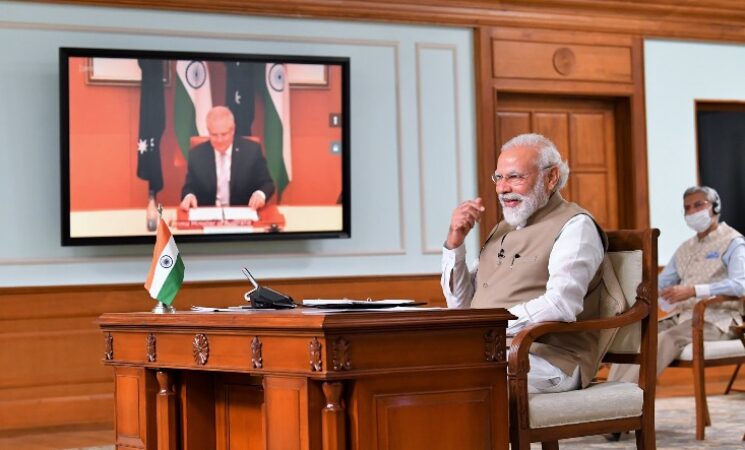30 November 2020, NIICE Commentary 6563
Smriti Singh Chauhan
COVID-19 has impacted every aspect of our life and even diplomacy is also not untouched. On 4 June 2020, first virtual summit between Prime Ministers Modi and Morris has been taken place. The two heads of governments were focused on two main aspects, firstly the principles of democracy and secondly, generating support for the region’s rule-based maritime order. The focal point of the summit was to construct a growing defence ties and shared approach towards a free, open, and inclusive Indo-Pacific region. The summit has shaped a vision of an “open, free, rules-based Indo-Pacific region…that promotes prosperous, stable, and sovereign states on the basis of shared interests.”
Indo-Australian Relationship
Indo –Australasian relationship has been a rollercoaster ride with a lot of ups and downs. Australian political will has always felt the lack of interest from the side of India. But the bilateral relationship has continued across both the governments despite being pulled down by failures on one or the other side. There are two major times in history when the Indo- Australian relationship reached its heights, the 1970s, and 1990s, in the 1970s due to the commonwealth heads of government meetings and secondly in the 1990s with the close friendship of Prime Ministers Bob Hawke and Rajiv Gandhi.
Recent Dimensions of Bilateral Ties
There are a lot of initiatives in the last decade which raised the expectations that both the countries should work together in the Indo-Pacific region. The Free Trade Agreement (FTA), the Regional Comprehensive Economic Partnership (RCEP), the Comprehensive Economic Co-operation Agreement (CECA) the Asian Infrastructure Investment Bank (AIIB) are major landmarks between the Indo-Australia bilateral relationship.
Through ASEAN and its various bodies, Trunbulll and Modi agreed to strengthen the cooperation in the Indo-pacific region. At the United Nations (UN), Australia always supported India as a permanent member of the UN Security Council. Again in 2017, in Joint Statement, the Prime Ministers re-stated their support for continued nuclear co-operation. Shelved at the time, but revived at Morrison’s meeting with Indian President Ram Nath Kovind in Canberra in November 2018, has once again revived the Indo- Australian relationships. The Varghese report, an India Economic Strategy to 2035, was seen as a key indicator of a fresh start for the bilateral relationship.
Virtual Summit
One of the most essential outcomes of the summit has been the release of the Joint Statement on a Comprehensive Strategic Partnership (CSP) between the Republic of India and Australia. Another factor for deliberation concerning the CSP is how their evaluation of the nature of the Indo-Pacific region has been subtly merged with the understanding of the two nations on the COVID-19. There is a profound dedication on both sides to address the COVID-19 challenge. The COVID-19 crisis becomes the foundation of greater science, technology, and research collaboration.
With this Comprehensive Strategic Partnership, the two nations have ensured that they have initiated the Australia-India Strategic Research Fund (AISRF) for new phase. The AISRF supports scientists of both the countries for working together and supports research collaboration in a different field such as biomedical devices, astrophysics, agriculture clean energy technologies, and astronomy. They have also agreed to enhance prospects in areas of cyber security, digital economy, and critical emerging technologies for building greater cyber-resilience.
The Joint Declaration on a Shared Vision for Maritime Cooperation in the Indo-Pacific is another outcome of this summit. The statement reiterated the enduring interest of both countries in a “free, open, inclusive and rules-based Indo-Pacific region.” By expressing concerns regarding non-traditional trade practices which are incoherent with international law, such as smuggling, drugs, piracy, human trafficking, terrorism, both the nations reflected their shared interest and ensure freedom of navigation and open sea lines of communication within the region.
ASEAN continues to be the stronghold of both the nation’s economical and political endeavours within the Indo-pacific region. The Indian Ocean Naval Symposium (IONS) and the Indian Ocean Rim Association (IORA) maintain to be viewed as institutions that can ensure the strong relationship for the two states in the region. The two countries also expressed their desire to develop the Indo-Pacific Oceans Initiative (IPOI), which shall focus on areas preserving marine ecology in the future.
A Comprehensive Economic Cooperation Agreement (CECA), the deliberations for which started in 2011, they did agree to re-engage on the bilateral CECA once again. The aim is to find a mutually agreed way to enhance the significant progress in the trading relationship between both the countries.
Conclusion
The India-Australia Virtual Summit has marked as a milestone in India-Australia relations. The changing geopolitical state of affairs has progressively pressed the two countries to obtain a new individualistic and non-dependent posture on the position and significance of dynamic regions like the Indo-Pacific in their strategic thinking. The mounting alliance between the two nations in areas of defence, science, and technology promises to support their relationship. Both the countries agreed to prolong their horizons and expand defence support by enhancing the capacity and complexity of their military exercises and defence engagement to address shared security challenges in the Indo-Pacific region. It will amplify military inter-operability during defence exercises and allow militaries of both the countries to utilize the bases for disaster relief and humanitarian cooperation, port and passage exercises with the reciprocal approach. In these hard times when major powers like the United States and China threaten to send tectonic tremors across the world order, the emergence of strong Indo-Australian relationship ensure that they are prepared to handle them and the summit was a step in that direction.

